Applied Mathematics, 2017, 8, 645-654
http://www.scirp.org/journal/am
ISSN Online: 2152-7393
ISSN Print: 2152-7385
Weighted Least-Squares for a Nearly Perfect
Min-Max Fit
Isaac Fried, Ye Feng
Department of Mathematics, Boston University, Boston, MA, USA
How to cite this paper: Fried, I. and Feng,
Y. (2017) Weighted Least-Squares for a
Nearly Perfect Min-Max Fit. Applied Ma-
thematics, 8, 645-654.
https://doi.org/10.4236/am.2017.85051
Received: February 28, 2017
Accepted: May 19, 2017
Published: May 22, 2017
Copyright © 2017 by authors and
Scientific Research Publishing Inc.
This work is licensed under the Creative
Commons Attribution International
License (CC BY 4.0).
http://creativecommons.org/licenses/by/4.0/
Abstract
In this note, we experimentally demonstrate, on a variety of analytic and
nonanalytic functions, the novel observation that if the least squares poly-
nomial approximation is repeated as weight in a second, now weighted, least
squares approximation, then this new, second, approximation is nearly perfect
in the uniform sense, barely needing any further, say, Remez correction.
Keywords
Least Squares-Approximation of Functions, Weighted Approximations,
Nearly Perfect Uniform Fits
Open Access
1. Introduction
Finding the min-max, or best L∞ , polynomial approximation to a function, in
some standard interval, is of the greatest interest in numerical analysis [1] [2].
For a polynomial function the least error distribution is a Chebyshev polynomial
[3] [4] [5].
The usual procedure [6] [7] to find the best L∞ approximation to a general
2L sense, easily ob-
function is to start with a good approximation, say in the
tained by the minimization of a quadratic functional for the coefficients, then
iteratively improving this initial approximation by a Remez-like correction pro-
cedure [8] [9] that strives to produce an error distribution that oscillates with a
constant amplitude in the interval of interest.
In this note, we bring ample and varied computational evidence in support of
the novel, worthy of notice, empirical numerical observation that taking the er-
2L , best polynomial fit to a function, squared,
ror distribution of a least squares,
as weight in a second, weighted, least squares approximation, results in an error
distribution that is remarkably close to the best L∞ , or uniform, approximation.
DOI: 10.4236/am.2017.85051 May 22, 2017
�
I. Fried, Y. Feng
2. Fixing Ideas; The Best Quadratic in [−1, 1]
The monic Chebyshev polynomial
( )
T x
2
=
−
1
x
x
2
1 , 1
2
− ≤ ≤ (1)
is the solution of the min-max problem
( )
e x
( )
e x
,
min max
a
x
=
2
x
−
a
− ≤ ≤ (2)
, 1
1.
x
x
This min-max solution, the least function in the L∞ sense, is a polynomial
that has two distinct roots, and oscillates with a constant amplitude in
(
( )
e
e
1 .
=
is such a po-
− ≤ ≤
1,
1
p x
e≤
lynomial, and
+
1
2
2e would intersect at two points, which is
1e and
in the interval, for otherwise
p x
p
absurd;
is either an identity, or has but the one
+
+
1
0
)
p
a
−
solution
.
1
1
Indeed, say
is another quadratic polynomial, then
)
1
− = −
2
e
x
=
2
( )
e
0
p
+
0
a x
=
1
a
−
0
a
+
0
= −
x
) (
+
p
0
x
x
a x
1
a
0
e
1
e
1
=
+
+
x
(
2
2
2
Thus, the monic Chebyshev polynomial of degree n is the least, uniform, or
nx by a polynomial of degree
pointwise, error distribution in approximating
1n − .
To obtain a least squares, a best
nimize
(
)
I a
2L , approximation to
2T x we first mi-
( )
(
I a
2
1
2
′
1
−
)
)
x
a
=
−
=
(
x I a
d ,
)
∫
1 3 0.3333
I p , under the weight (
(
)
1 3
=
(
=
)
) (
(
x I p
d ,
−
.
p
)
x
2
2
2
to have the value
a =
Minimizing next
(
I p
)
=
(
2
x
−
1
1
−
∫
p =
now with respect to p, we obtain
closer to the optimal value of one half.
(
2
x
−
a
)
d
x
=
0
(3)
1
1
−
∫
a
2
′
x
∫
−
(
11 21 0.5238
=
x
1
−
1
2
1 3
,
)2
−
a
=
)(
p x
2
−
1 3 d
x
=
0
(4)
2
)
, which is surprisingly much
We may replace the difficult L∞ measure by the computationally easier
mL
a δ
measure with an even
+
0
be an improved one. Minimization cum linearization produces the equation
1m . Let a0 be a good approximation, and
a
1
=
1
1
−
(
2
x
−
a
0
n
)
d
x n
−
∫
δ
1
1
−
(
2
x
−
a
0
n
−
) 1
d
x
=
0
(5)
where
∫
n is odd.
a =
0
a =
1
Starting with
17
, the value
1
n =
11 21 0.5238
=
, as compared with the optimal
0.495
, we obtain from the above equation, for
a =
0.5
.
3. Optimal Cubic in [−1, 1]
Seeking to reproduce the optimal monic Chebyshev polynomial of degree three
( )
T x
3
=
3
x
−
3 , 1
x
4
− ≤ ≤ (6)
1
x
we start by minimizing
∫
(
I a
1
=
)
)1
(
I a
(
1
−
x
3
1
−
a x
1
2
)
(
x I a
d ,
1
′
)
=
646
(
x x
3
−
a x
1
)
x
d
=
0
(7)
1
1
−
∫
�
I. Fried, Y. Feng
and have
a =
1
3 5
=
0.6
.
Then we return to minimize the weighted
) (
x
) (
2
a x
1
(
I p
1
(
′
I p
1
(
x
(
x x
)
)
a x
1
1
−
1
=
−
=
−
2
1
3
3
∫
∫
3
1
−
2
)1
)
p x
1
p x
1
−
−
3
x
(
I p with respect to
1p
x
d ,
)
d
x
(8)
=
0
and obtain
=
value of 0.75. See Figure 1.
p =
1
195 253 0.770751
, which is considerably closer to the optimal
We are ready now for a Remez-like correction to bring the error function closer
occurs at m = 0.50687. We
, by which
x
and request that
( )
e x
3
x
−
x
0.770751
(
e m e
( )1
=
a x
1
to optimal. The minimum of
=
write a new tentative
we have
( )
e x
−
−
=
)
3
a
1
=
1
+
1
+
3
m
m
=
0.750047
(9)
as compared with the Chebyshev optimal value of
a =
1
3 4
=
0.75
.
4. Optimal Quartic in [0, 1]
Starting with
( )
e x
=
4
x
+
3
a x
3
+
2
a x
2
+
a x a
1
0
+
(10)
we minimize
and obtain the best, in the
2L sense,
(
I a a a a
,
3
,
,
0
1
2
1
0
2
x
d
= ∫
( )
e x
)
( )
e x shown in Figure 2.
(11)
Then we return to minimize
1
∫
( )
e x squared, and obtain the new, nearly perfectly
(
I p p p p
3
(12)
( ) (
e x
p x
2
p x
3
p x
1
)2
x
d
p
0
=
+
+
+
+
x
)
,
,
,
2
4
3
2
0
0
1
2
weighted by the previous
uniform
( )
e x of Figure 3.
By comparison, the amplitude of the monic Chebyshev polynomial of degree
four in [0,1] is 1/128 = 0.0078125.
Figure 1. (a) Least squares cubic. (b) Weighted least squares cubic.
647
�
I. Fried, Y. Feng
648
+
1
7!
7
x
(13)
Figure 2. Least squares quartic.
Figure 3. Weighted least squares quartic.
5. Best Cubic Approximation of ex in [0, 1]
To facilitate the integrations we use the approximation
1
6!
= + +
1
4!
1
2!
1
5!
1
3!
+
+
+
+
1
x
x
x
x
x
x
e
2
3
4
5
x
6
and minimize
,
(
I a a a a
,
3
,
0
1
2
)
=
1
0
∫
,
2
( )
e x
( )
x e x
d ,
+
+
+
=
a
0
a x a x
1
2
ex
( )
e x obtained from this minimization is
(14)
a x
3
+
2
3
a a a a . The best
with respect to
,
0
shown in Figure 4.
,
1
2
3
�
Then we use the square of the minimal
( )
e x just obtained, as weight in the
next minimization of
I. Fried, Y. Feng
(
I p p p p
3
,
,
,
0
1
2
)
=
1
0
∫
( ) (
e x
2
x
e
+
p
0
+
p x
1
+
2
p x
2
+
3
p x
3
)2
x
d
(15)
with respect to
p p p p .
0
3
,
,
,
1
2
The nearly perfect result of this last minimization is shown in Figure 5.
6. Best Cubic Approximation of sinx in [0, 1]
To facilitate the integrations we take
sin
x
= −
x
1
3!
3
x
+
1
5!
5
x
−
1
7!
7
x
+
1
9!
9
x
(16)
and obtain the least squares error distribution as in Figure 6.
The subsequent nearly perfect weighted least squares error distribution is
shown in Figure 7.
Figure 4. Least squares cubic fit to ex.
Figure 5. Weighted least squares cubic fit to ex.
649
�
I. Fried, Y. Feng
Figure 6. Least squares cubic fit to sinx.
Figure 7. Weighted least squares cubic fit to sinx.
7. Best Quadratic Fit to
x in [0, 1]
We start with
under the condition
( )
e x
=
x
−
(
a
0
+
a x a x
1
2
+
)2
, 0
≤ ≤ (17)
1
x
e
( )
0
= −
e
( )
1 ,
a
0
=
1
2
(
1
−
a
1
−
a
2
)
(18)
and minimize
(
I a a
,
2
1
)
=
1
0
∫
x
− −
1
2
a x
1
−
1
2
−
a
2
2
x
−
2
1
2
d
x
(19)
with respect to
1a and
( )
e x
2a , to have
1
10
−
x
=
+
121
70
x
−
13
14
2
x
, 0
≤ ≤
x
1
(20)
shown as curve a in Figure 8.
Next we minimize
650
�
I. Fried, Y. Feng
Figure 8. (a) Least squares quadratic fit to
to
x .
x . (b) Weighted least squares quadratic fit
(
I p p
2
,
1
)
=
1
∫
0
⋅
−
x
− −
1
2
x
−
1
10
p x
1
121
70
+
1
2
−
13
14
p
2
2
x
−
2
1
2
2
x
2
d
x
(21)
x
−
and obtain
( )
e x
=
x
−
(
0.064 1.949
+
x
−
1.077
x
)2
, 0
≤ ≤ (22)
1
x
shown as graph b in Figure 8, as compared with the optimal, in the L∞ sense
( )
e x
=
x
−
(
0.0674385 1.93059
+
x
−
1.06547
x
, 0
≤ ≤ (23)
1.
x
)2
8. Best Cubic Fit to x1/4 in [0, 1]
We start with
+
a
0
( )
1
( )
e x
=
1 4
x
+
a x a x
1
2
+
2
+
3
a x
3
, 0
≤ ≤ (24)
1
x
e
a
3
e=
, or
( )
0
(
1
∫
1
= − −
(
a x
1
a a a to have the minimal
0
1 4
x
a
0
=
−
+
+
x
,
3
0
2
−
3
x
a
1
a
2
, and minimize
(
a x
2
−
)
( )
e x shown in Figure 9.
)2
+
−
d
)
x
x
2
3
(25)
under the restriction
)
(
I a a a
,
2
,
0
1
with respect to
,
1
Then we minimize
1
∫
(
I p p p
2
=
)
,
,
1
0
0
2
( )
e x
(
1 4
x
−
3
x
+
p
0
+
(
p x
1
−
3
x
)
+
(
p x
2
2
−
3
x
)
)2
d
x
(26)
and obtain the nearly optimal error distribution as in Figure 10.
9. Another Difficult Function
We now look at the error distribution
3
a x
3
ln 1.001
( )
e x
=
+
−
x
(
)
(
+
2
a x
2
+
a x a
1
0
+
)
, 1
− ≤ ≤ (27)
1
x
651
�
I. Fried, Y. Feng
under the condition that
(
e=
Least squares minimization of
( )
1
e
11.
a
3
)
− , or
1
( )
e x yields the error distribution in Figure
3.8007012
a
1
=
−
.
Next we minimize
(
∫
I p p p p
3
=
)
,
,
,
0
1
2
1
1
−
2
( )
e x
(
ln 1.001
(
+
)
−
(
x
3
p x
3
+
2
p x
2
+
p x
1
+
p
0
)
)2
x
d
(28)
Figure 9. Least squares cubic fit to
1 4x
.
Figure 10. Weighted least squares cubic fit to
1 4x
.
Figure 11. Least squares cubic fit to
ln 1.001 x+
(
)
.
652
�
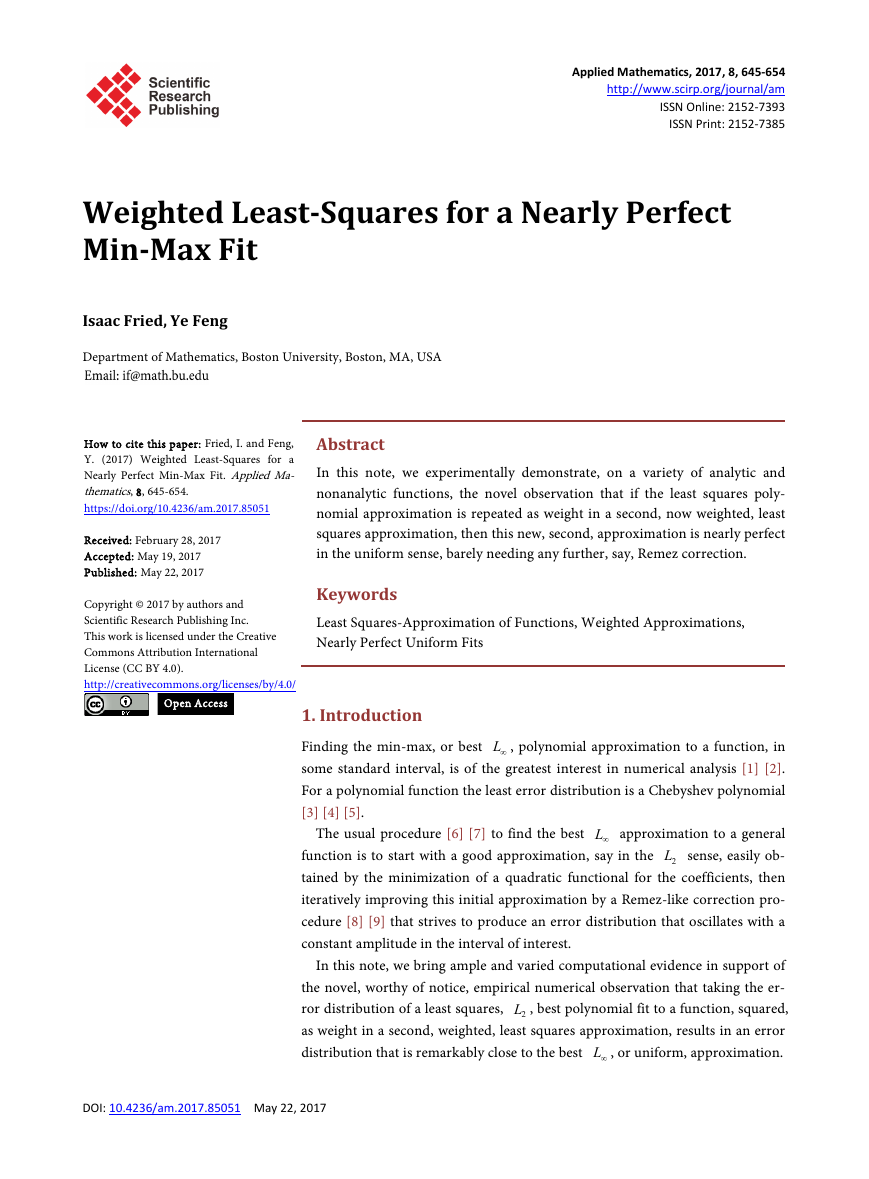
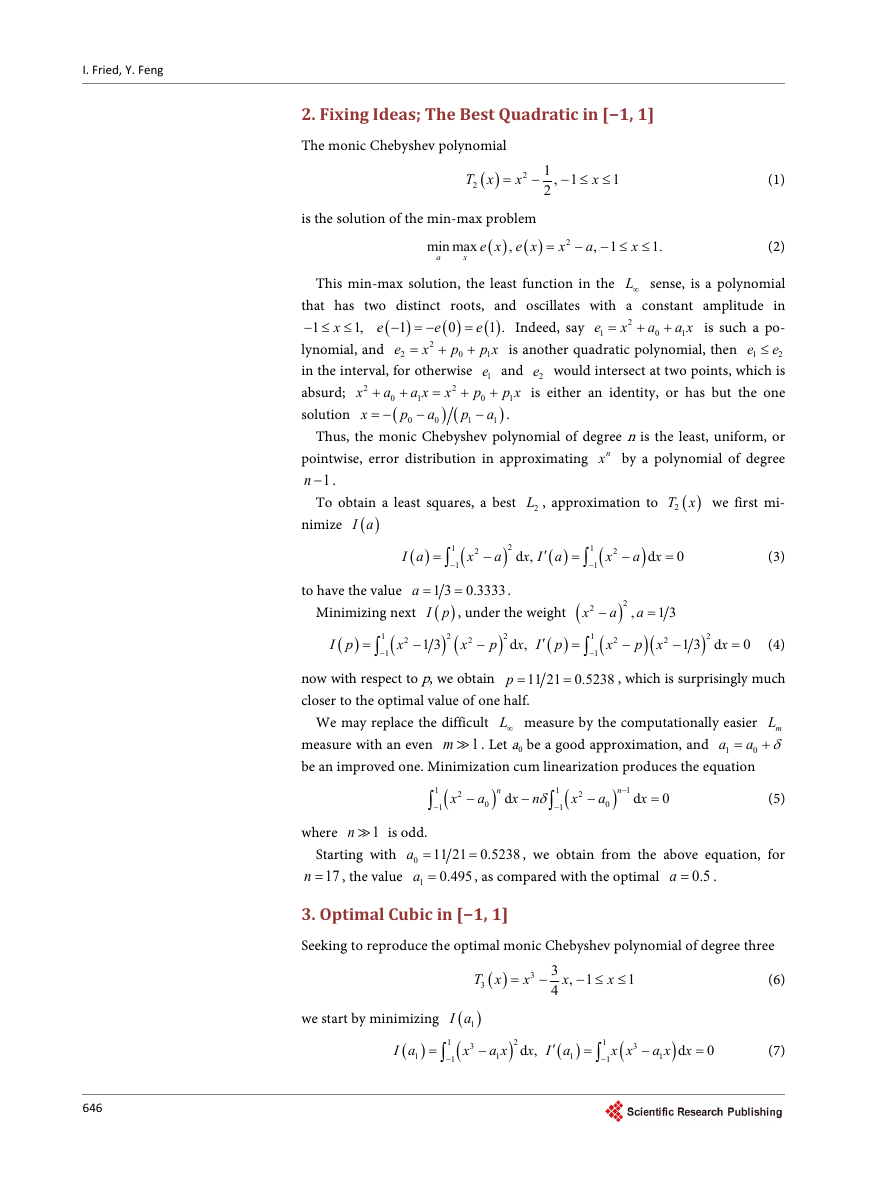
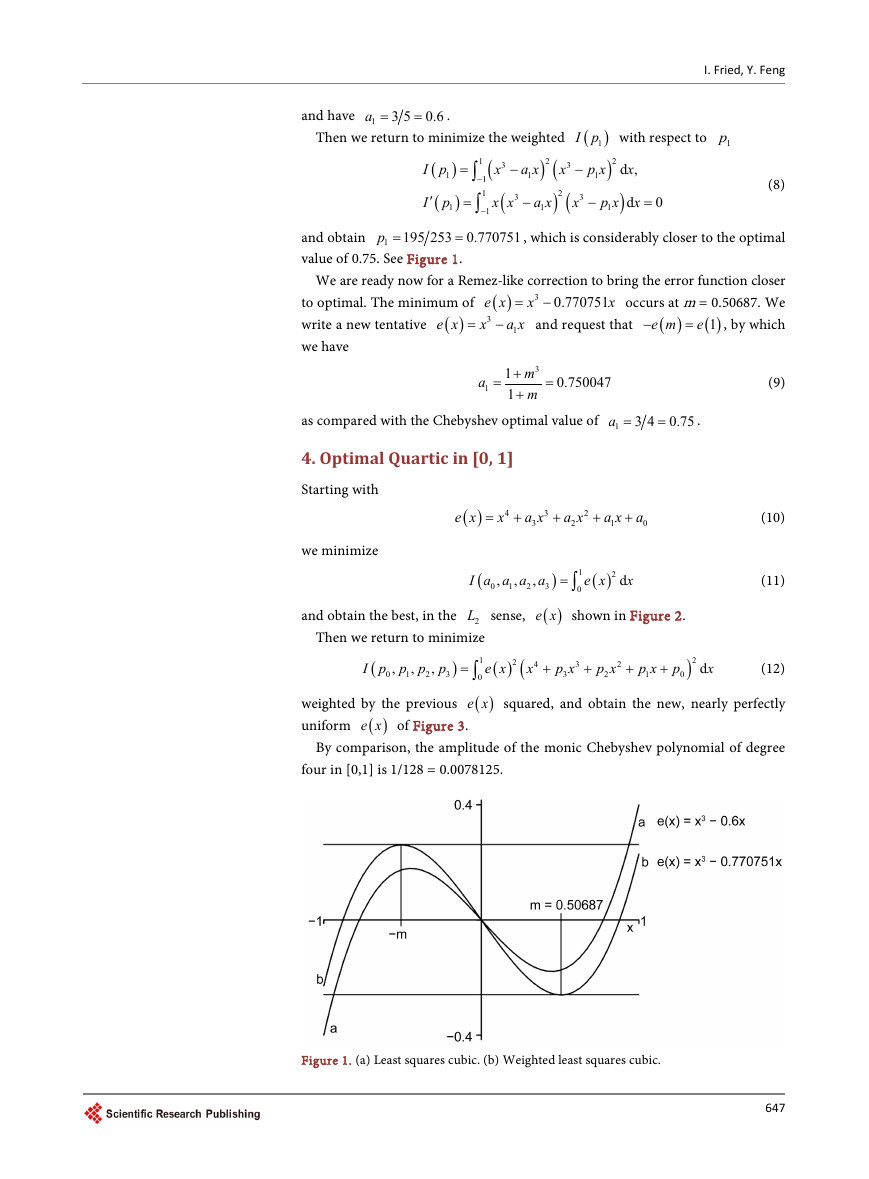
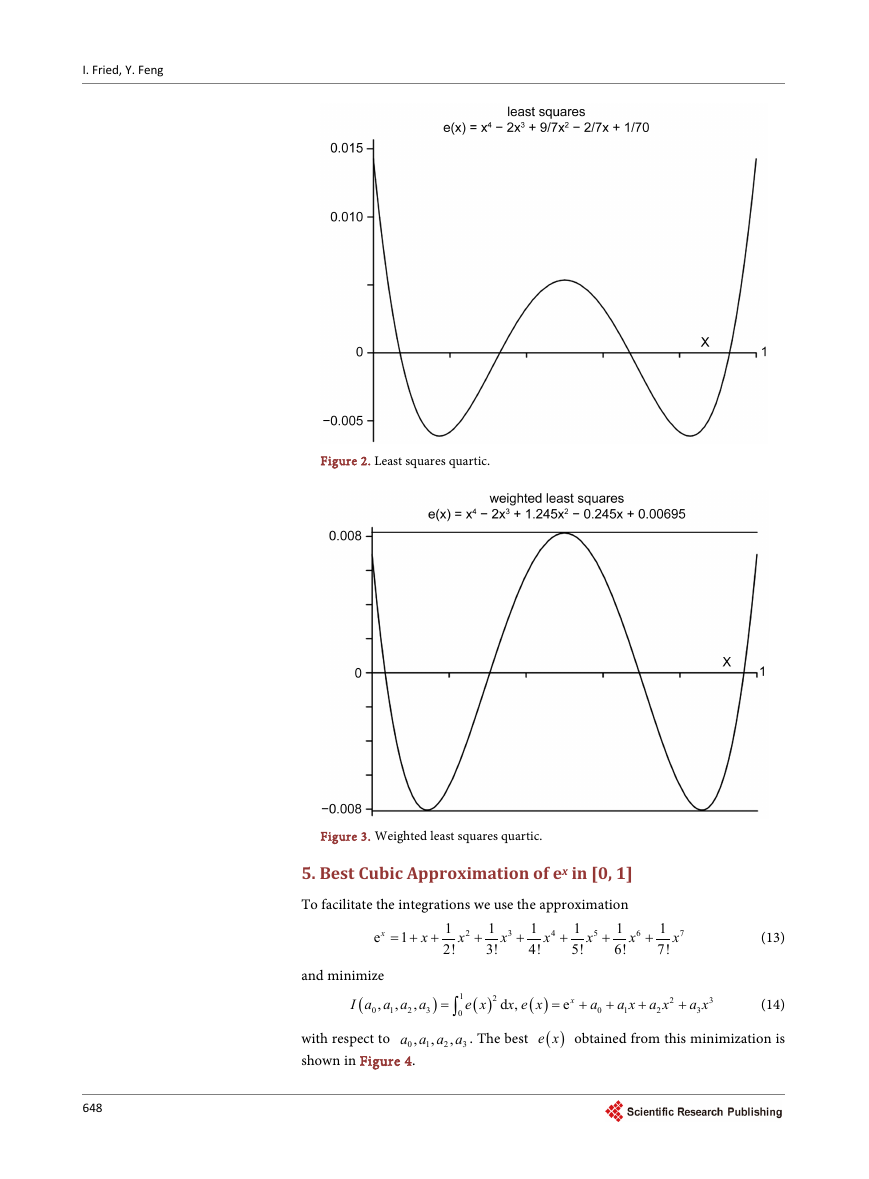
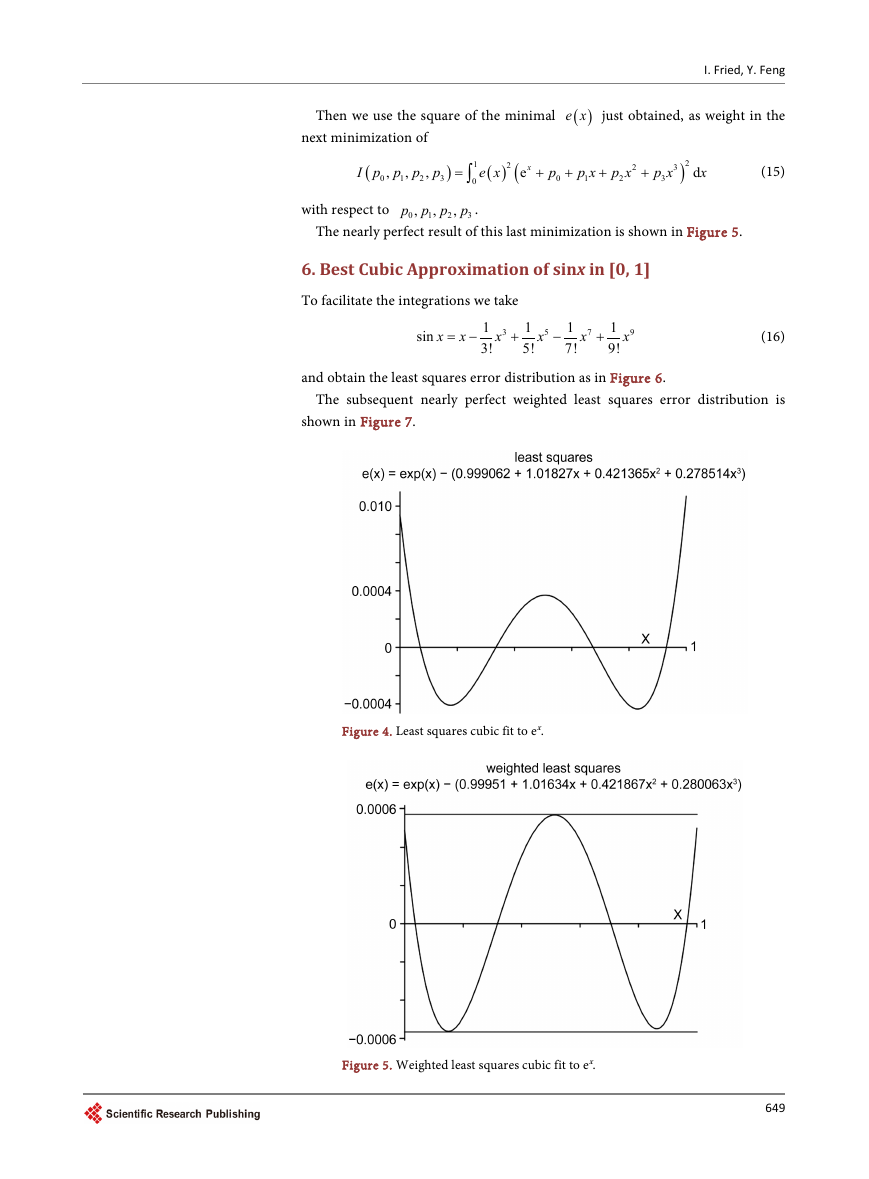
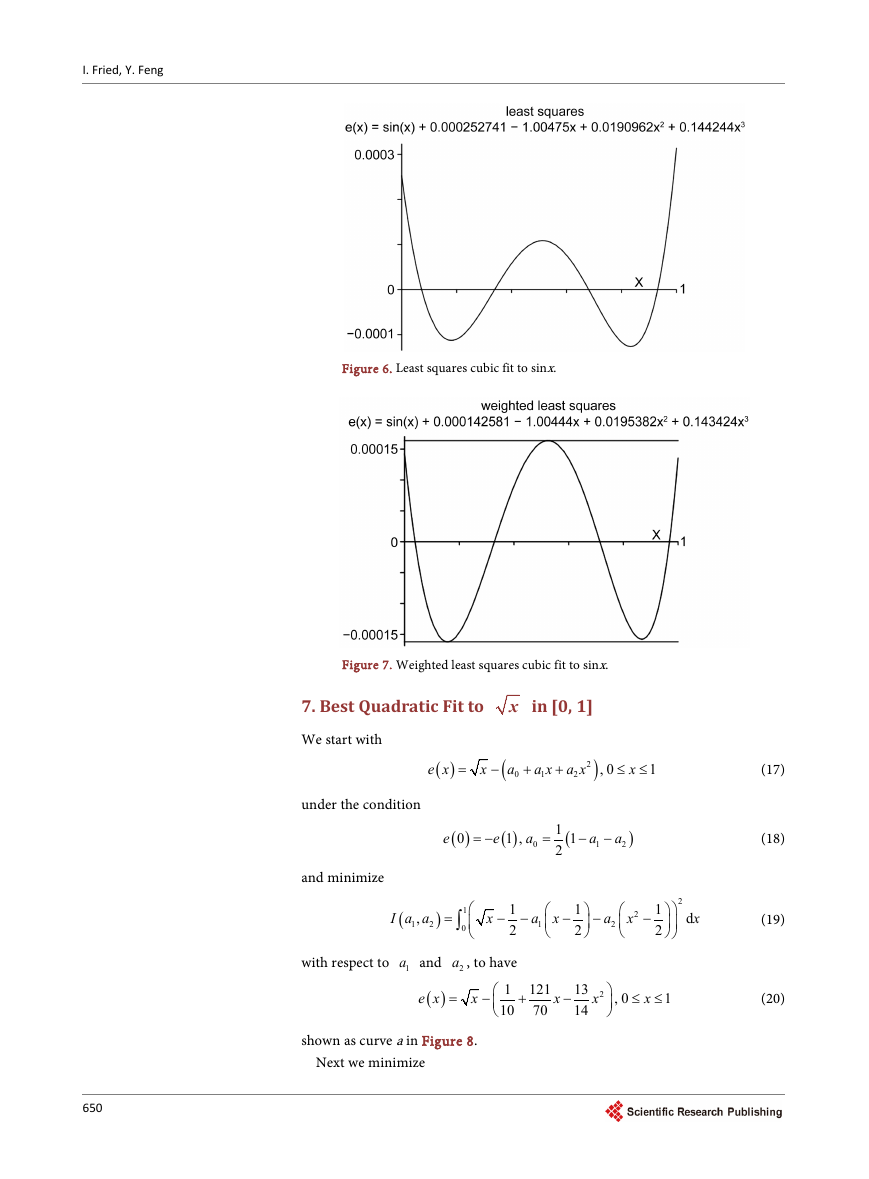

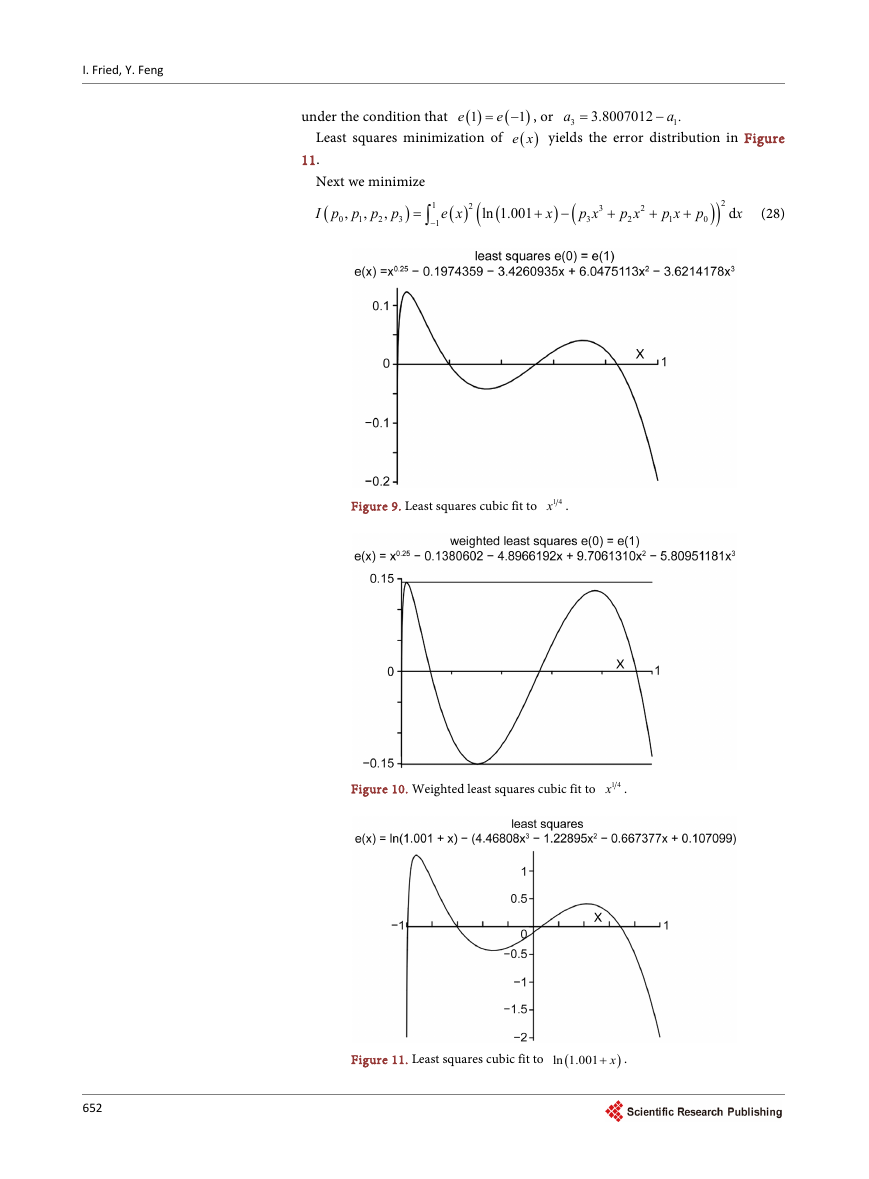








 2023年江西萍乡中考道德与法治真题及答案.doc
2023年江西萍乡中考道德与法治真题及答案.doc 2012年重庆南川中考生物真题及答案.doc
2012年重庆南川中考生物真题及答案.doc 2013年江西师范大学地理学综合及文艺理论基础考研真题.doc
2013年江西师范大学地理学综合及文艺理论基础考研真题.doc 2020年四川甘孜小升初语文真题及答案I卷.doc
2020年四川甘孜小升初语文真题及答案I卷.doc 2020年注册岩土工程师专业基础考试真题及答案.doc
2020年注册岩土工程师专业基础考试真题及答案.doc 2023-2024学年福建省厦门市九年级上学期数学月考试题及答案.doc
2023-2024学年福建省厦门市九年级上学期数学月考试题及答案.doc 2021-2022学年辽宁省沈阳市大东区九年级上学期语文期末试题及答案.doc
2021-2022学年辽宁省沈阳市大东区九年级上学期语文期末试题及答案.doc 2022-2023学年北京东城区初三第一学期物理期末试卷及答案.doc
2022-2023学年北京东城区初三第一学期物理期末试卷及答案.doc 2018上半年江西教师资格初中地理学科知识与教学能力真题及答案.doc
2018上半年江西教师资格初中地理学科知识与教学能力真题及答案.doc 2012年河北国家公务员申论考试真题及答案-省级.doc
2012年河北国家公务员申论考试真题及答案-省级.doc 2020-2021学年江苏省扬州市江都区邵樊片九年级上学期数学第一次质量检测试题及答案.doc
2020-2021学年江苏省扬州市江都区邵樊片九年级上学期数学第一次质量检测试题及答案.doc 2022下半年黑龙江教师资格证中学综合素质真题及答案.doc
2022下半年黑龙江教师资格证中学综合素质真题及答案.doc